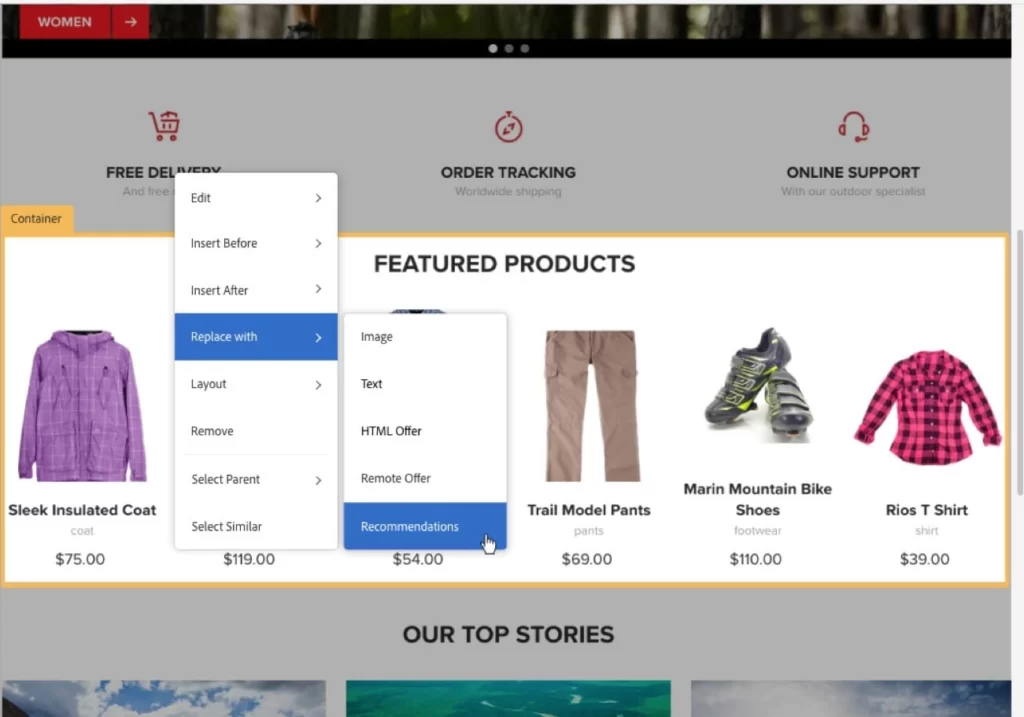In 2025, business-to-business commerce is shaped largely by digital transformation and smart technologies, especially artificial intelligence. B2B transactions now happen through advanced platforms using composable architectures that allow flexibility and quick innovation.
Buyers expect a smooth, personalized experience similar to what they get in consumer shopping, with self-service options like instant quotes and order tracking becoming standard. AI supports everything from demand forecasting to real-time pricing and procurement decisions that consider sustainability goals.
Companies investing in unified commerce systems benefit from seamless data flow across channels like mobile, chat, and social media. Overall, B2B commerce focuses on efficiency, customer empowerment, and responsible practices for lasting success.
What B2B Commerce Means in 2025
B2B commerce in 2025 goes far beyond traditional buying and selling between businesses. It is a digitally driven ecosystem where AI, composable architectures, and real-time data converge to create fast, personalized, and seamless purchasing experiences that mirror the conveniences found in consumer retail.
Buyers now expect intuitive self-service tools that let them manage orders, pricing, and shipments independently, reducing reliance on sales teams while still valuing human collaboration for complex decisions. Commerce platforms have evolved into flexible, API-first systems that adapt quickly to changing business needs, enabling companies to innovate without being locked into rigid structures.

AI plays a critical role by delivering predictive insights, automating content, and enabling dynamic pricing that responds to market shifts in real time. Meanwhile, data synchronization across channels ensures accuracy in inventory and order status, providing a unified buying journey across multiple touchpoints.
Compliance and sustainability are no longer afterthoughts but core to procurement and supplier choices, reflecting growing demands for responsible business practices. In essence, B2B commerce in 2025 balances cutting-edge automation with meaningful human interaction, delivering efficient, transparent, and customer-focused experiences that meet the heightened expectations of modern business buyers.
AI Driving Smarter B2B Operations
In 2025, AI is deeply woven into the core of B2B operations, moving well beyond pilot projects to become a standard across procurement, sales, and customer service. Predictive analytics are now essential for forecasting demand and spotting churn risks early, allowing businesses to act proactively.
Generative AI tools automate routine responses, craft personalized sales content, and provide real-time guidance to sales reps, freeing them to focus on more consultative interactions. Dynamic pricing powered by AI adjusts offers instantly based on buyer profiles and market conditions, ensuring competitive and tailored deals.
Procurement bots continuously analyze factors like costs, supplier reliability, and ESG scores, helping companies make smarter, more responsible decisions. AI not only reduces manual errors through automated workflows but also accelerates order processing and improves compliance by monitoring risks and generating real-time alerts.

Personalization at scale has become a reality, with AI customizing catalogs and cross-sell opportunities for each account. Many companies now deploy AI “coworkers” that collaborate with human teams to enhance efficiency and support better decision-making, marking a new era where AI and humans work side by side to drive smarter B2B commerce.
- AI is embedded across procurement, sales, and customer service workflows, not just experimental.
- Predictive analytics help forecast demand and identify churn risks early.
- Generative AI automates responses, creates sales content, and guides reps in real time.
- AI-driven dynamic pricing adjusts offers based on buyer profiles and market conditions.
- Procurement bots analyze costs, ESG scores, and supplier reliability automatically.
- AI augments sales teams by providing recommendations and freeing them to focus on consultative selling.
- Automated AI workflows reduce manual errors and speed up order processing.
- Risk detection and compliance monitoring use AI for real-time alerts and reporting.
- AI-powered personalization tailors catalogs and cross-sell offers per account.
- By 2025, many companies deploy AI ‘coworkers’ to improve efficiency and decision-making.
Modern Procurement and Buyer Experience
In 2025, procurement is shaped by AI-driven automation that streamlines routine tasks such as order approvals and catalog updates, reducing manual errors and speeding up purchasing cycles. Punchout catalogs enable buyers to shop directly within supplier systems, making the process more seamless and efficient.
Automated email order ingestion further cuts down on manual data entry, minimizing mistakes and accelerating order processing. Custom approval workflows balance control with speed, allowing organizations to maintain compliance without slowing down procurement.

Buyers now expect instant quotes and personalized pricing through self-service portals, reflecting the shift toward digital-first, empowered purchasers. Sustainability factors are also front and center, with procurement decisions integrating ESG criteria and supplier sustainability ratings to support responsible sourcing.
Mobile-friendly procurement interfaces let decision-makers act on orders anytime, anywhere, supporting faster, more flexible buying. Integration with ERP and finance systems keeps data consistent and transparent, ensuring smooth collaboration across departments.
Overall, the procurement experience in 2025 prioritizes ease, speed, and accuracy to meet the expectations of modern B2B buyers who demand efficiency and personalization in their purchasing journey.
Composable Commerce and Flexible Systems
Composable commerce replaces bulky, one-size-fits-all platforms with modular, API-first components that businesses can mix and match. This flexibility lets companies build commerce stacks tailored to their unique needs and markets, rather than settling for rigid systems.
With composable architectures, new features can be rolled out quickly and integrations with other tools happen smoothly, enabling faster innovation cycles. These systems are designed to be extensible, allowing businesses to add custom workflows and connect with specialized applications.
This adaptability is crucial as buyer expectations and market conditions shift rapidly. Most B2B brands now see composability as essential for staying agile and future-proof.

By unifying data from various sources through APIs, composable commerce delivers consistent and seamless experiences to buyers, whether they engage online, offline, or through hybrid sales models. It also reduces reliance on a single vendor, letting companies adopt new technologies gradually without disrupting core operations.
This approach encourages experimentation and continuous improvement, keeping businesses competitive without risking their foundational processes.
Empowering Buyers with Self-Service Options
Self-service portals are central to B2B commerce in 2025, enabling buyers to independently generate quotes, place complex orders, and manage invoices without needing sales rep assistance. These portals offer personalized catalogs, pricing, and access to order histories on demand, giving buyers control and transparency throughout the purchasing journey.
Shipment tracking and status updates are also available anytime, reducing friction and speeding up routine transactions. With buyers expecting seamless access from desktop or mobile devices, these digital tools support multi-user approval workflows that fit within organizational procurement processes.
Integration with procurement software ensures data flows smoothly and compliance requirements are met. This shift allows sales teams to move away from transactional tasks toward providing higher-value consultative support and relationship building.
Automation handles repetitive workflows, improving operational efficiency and lowering costs, while enhancing buyer satisfaction by delivering a fast, flexible, and user-friendly purchasing experience.
Scaling Hyper-Personalization in B2B
In 2025, hyper-personalization in B2B commerce moves beyond simple customization to become a dynamic, AI-driven strategy that adapts in real time to each buyer’s unique profile. Static catalogs and one-size-fits-all pricing models are replaced by account-specific offerings that reflect negotiated agreements, volume discounts, and contract terms.
AI analyzes buyer behavior, industry sector, and geographic location to deliver tailored product recommendations and dynamically adjust cross-sell and upsell suggestions. This level of personalization extends into content, addressing the specific challenges and needs of different buyer segments with relevant insights and solutions.

Communication channels and timing are also personalized to match buyer preferences, increasing engagement and response rates. By investing heavily in scalable personalization tools, B2B companies differentiate their brands in a competitive market, creating seamless, relevant buyer experiences that drive larger order sizes and deeper customer loyalty.
Continuous data-driven insights allow businesses to refine these personalization strategies over time, ensuring they stay aligned with evolving buyer expectations and market conditions.
Leveraging Real-Time Data and Unified Commerce
In 2025, real-time data synchronization is a fundamental part of B2B commerce, ensuring inventory levels, pricing, order statuses, and customer information are always up to date. This immediacy helps both buyers and sellers avoid delays and inaccuracies that used to slow transactions.
Unified commerce platforms take this further by blending all sales channels, online stores, physical locations, mobile apps, chat, and social media, into a single, connected system. Buyers benefit from consistent information and seamless transitions no matter which channel they use, supporting complex purchasing journeys involving multiple stakeholders.
These platforms break down data silos, improving operational accuracy and delivering real-time alerts that notify sales teams and buyers instantly about changes such as stock updates or price adjustments. Integration with ERP, CRM, and supply chain systems offers end-to-end visibility, making it easier to track orders and manage relationships.
Transparency in data reduces disputes and builds trust between businesses. Meanwhile, real-time analytics enable companies to act proactively, tailoring marketing efforts and sales strategies to buyer behavior.
Unified commerce solutions also simplify technology management and scale with business growth, making them essential tools for B2B companies aiming to meet the expectations of digital-first, empowered buyers.
Omnichannel Integration for B2B Buyers
In 2025, B2B buyers expect a smooth and consistent experience across multiple channels such as email, WhatsApp, LinkedIn, procurement portals, and more. Over 80% of buyers interact through several touchpoints before making a purchase, making omnichannel integration essential.
This integration ensures that buyers can move seamlessly from one channel to another without losing context or data, preserving the flow of information like pricing, availability, and order status in real time. Mobile apps and messaging platforms have become primary communication tools, while social media increasingly supports research and engagement, influencing buying decisions.

A well-executed omnichannel strategy unifies marketing, sales, and customer service efforts, allowing businesses to deliver personalized interactions that respect each buyer’s channel preferences. This approach supports the complex nature of B2B buying processes, which often involve long decision cycles and multiple stakeholders.
By leveraging technology to provide consistent, connected experiences across all channels, companies can meet the expectations of the modern, digital-first B2B buyer while streamlining the path to purchase.
Automation and Extensibility in Commerce
In 2025, automation in B2B commerce has moved well beyond simple digitization of manual tasks like quote negotiation, order entry, and approvals. These processes are now fully automated to reduce errors, speed up operations, and lower costs.
Modern platforms employ composable architectures, allowing businesses to extend workflows with custom features tailored to unique industry needs, rather than relying solely on out-of-the-box capabilities. Automation covers everything from document processing and compliance checks to managing exceptions, ensuring smooth and reliable transactions.
APIs play a critical role by integrating third-party tools and internal systems, enabling end-to-end automation that streamlines operations across departments. Robotic Process Automation (RPA), combined with AI, handles repetitive tasks efficiently, freeing sales and procurement teams to focus on strategic work like relationship building and negotiation.
This framework also supports scalability, helping companies handle growth or seasonal demand spikes without operational bottlenecks. Additionally, automation systems include audit trails and compliance reporting, providing transparency and accountability essential for regulatory adherence.
Overall, automation and extensibility empower businesses to adapt quickly, improve accuracy, and maintain agility in a fast-evolving B2B commerce landscape.
Compliance, Data Privacy, and Sustainability
In 2025, compliance is a foundational part of B2B commerce, embedded directly into digital workflows to prevent costly fines and protect brand reputation. Automated risk monitoring tools flag potential breaches or policy violations in real time, allowing businesses to respond swiftly.
Regulations like GDPR and CCPA continue to shape how buyer data is collected, stored, and used, pushing companies to maintain transparency and build trust. Responsible AI frameworks guide the ethical deployment of automation and decision-making, ensuring AI tools operate without bias or unintended harm.
Sustainability has become a key factor in procurement and supplier selection, with firms managing supplier risks related to labor practices, environmental impact, and governance issues proactively. ESG compliance is no longer manual but tracked and reported automatically through integrated commerce systems, aligning sustainability goals with business objectives and buyer expectations.
This integration ensures that companies not only meet regulatory requirements but also demonstrate accountability and transparency, which buyers now expect as part of the purchasing experience.
Business Implications of B2B Commerce Trends
The shift toward AI-driven B2B commerce in 2025 fundamentally changes how businesses operate and compete. Automation of procurement processes minimizes manual errors and speeds up purchasing cycles, directly improving operational efficiency and reducing costs.
By adopting composable commerce architectures, companies can quickly customize and scale their digital platforms, allowing them to respond to changing market demands without lengthy development delays. Self-service portals empower buyers to handle complex orders, generate quotes, and track shipments independently, which frees sales teams to focus on strategic, consultative selling rather than routine tasks.
Real-time data synchronization ensures consistent inventory, pricing, and customer information across all channels, supporting seamless unified commerce experiences that modern buyers expect. Hyper-personalization, such as account-specific catalogs and AI-based recommendations, helps businesses increase buyer loyalty and boost average order values by tailoring offers precisely.
Compliance and ESG priorities are no longer optional; they are embedded in procurement decisions to meet regulatory standards and sustainability goals, reducing risk and supporting brand reputation. Sales teams now collaborate with AI coworkers that provide predictive insights, making decision-making faster and more informed.
Integrating multiple communication channels into an omnichannel commerce experience allows businesses to meet buyers wherever they are, ensuring smooth interactions across email, social media, and procurement portals. Overall, investing in AI-centric, customer-focused strategies is critical for businesses to stay competitive and align with the evolving expectations of digital-first B2B buyers.
Real-World Examples of B2B Commerce in 2025
In 2025, real-world B2B commerce examples highlight the shift toward smarter, faster, and more sustainable business transactions. Siemens uses AI-powered procurement tools that not only optimize costs but also ensure suppliers meet environmental, social, and governance standards, reflecting the growing importance of ESG in buying decisions.
PROS and Microsoft have teamed up to deliver AI-driven smart quoting solutions that accelerate the sales cycle by generating personalized offers in real time, helping sales teams respond quickly to buyer needs. Ingersoll Rand demonstrates the power of composable commerce by rapidly launching new eCommerce sites tailored to different markets and customer groups, thanks to modular, flexible components.
Similarly, Wild Fork Foods leverages dynamic pricing models enabled by composable commerce extensibility to instantly adjust prices based on supply and demand, maintaining competitiveness and profitability. Many companies now integrate AI procurement agents that evaluate suppliers using comprehensive cost, compliance, and sustainability data, making supplier selection more accurate and aligned with corporate values.
To reduce errors and speed up procurement, enterprises implement punchout catalogs and automated email order ingestion, streamlining traditional manual processes. Sales teams benefit from AI coworkers that provide real-time guidance, automate content creation, and score leads, boosting efficiency without losing the human touch.
Organizations unify all sales channels, including mobile apps, chat, and social media, into seamless buyer journeys with consistent information, reflecting the omnichannel expectations of modern B2B buyers. Automated workflows have replaced paper-based quote negotiations and approvals, reducing delays and improving deal accuracy.
Finally, firms embed compliance monitoring and responsible AI frameworks directly into commerce platforms to manage risks effectively and maintain buyer trust, demonstrating a balanced approach to innovation and governance.
Future Outlook for B2B Commerce
By 2025, B2B commerce will be firmly rooted in digital channels, with approximately 80% of sales interactions occurring online. This shift makes digital commerce platforms essential for business success, as buyers expect fast, seamless experiences similar to what they encounter in B2C environments.
AI will play a growing role, with 40% of companies leveraging AI coworkers to assist sales teams, improving efficiency and supporting smarter decision-making. The rise of composable commerce architectures will enable businesses to stay agile, allowing them to rapidly integrate new technologies and scale operations without the constraints of monolithic systems.
Customer-centricity will remain a top priority, driving investments in omnichannel strategies that deliver consistent, real-time information on inventory, pricing, and order status across all touchpoints. Hyper-personalization powered by AI will become standard, enabling companies to tailor pricing and product recommendations dynamically to meet the unique needs of each buyer.
Sustainability and ESG considerations will increasingly influence procurement decisions, reflecting broader corporate responsibility goals. Automation will continue to streamline manual processes, reducing errors and accelerating purchasing cycles, which frees teams to focus on higher-value activities.
Human-AI collaboration will evolve to balance efficiency with the importance of trusted relationships, as AI augments rather than replaces the human element in sales and procurement. With the pace of innovation accelerating, businesses must prioritize adaptability and quick technology adoption to remain competitive and meet rising buyer expectations.

Frequently Asked Questions
1. How is B2B commerce expected to evolve by 2025 in terms of technology use?
By 2025, B2B commerce will likely integrate more advanced technologies like AI, machine learning, and blockchain to streamline operations, improve decision-making, and increase transparency across supply chains.
2. What role will customer experience play in B2B commerce in 2025?
Customer experience will become a critical focus in B2B transactions, with businesses adopting personalized platforms, faster response times, and seamless digital interactions to better serve their clients and build long-term partnerships.
3. How will automation impact the B2B buying and selling process in 2025?
Automation will simplify repetitive tasks such as order processing and inventory management, allowing companies to reduce human error, accelerate workflows, and focus more on strategic growth and relationship management.
4. What trends in sustainability might influence B2B commerce strategies by 2025?
Sustainability will shape B2B commerce as companies prioritize eco-friendly materials, ethical sourcing, and carbon footprint reduction, driven by buyer demand and regulatory pressures to promote responsible business practices.
5. How important will data security and privacy be for B2B commerce in 2025?
With increasing digital transactions, data security and privacy will be paramount in B2B commerce, prompting firms to invest heavily in cybersecurity measures and comply with stricter regulations to protect sensitive information.
Conclution
B2B commerce in 2025 is defined by digital-first buyers and advanced tech like AI, composable architectures, and real-time data. Businesses are focusing on smarter procurement, self-service options, and hyper-personalization to offer seamless, personalized buying experiences. Unified commerce platforms connect multiple sales channels, while automation and compliance ensure efficiency and trust. The shift to flexible, AI-powered systems is accelerating, with companies needing to embrace these trends to stay competitive and meet evolving buyer expectations.




Leave a Reply